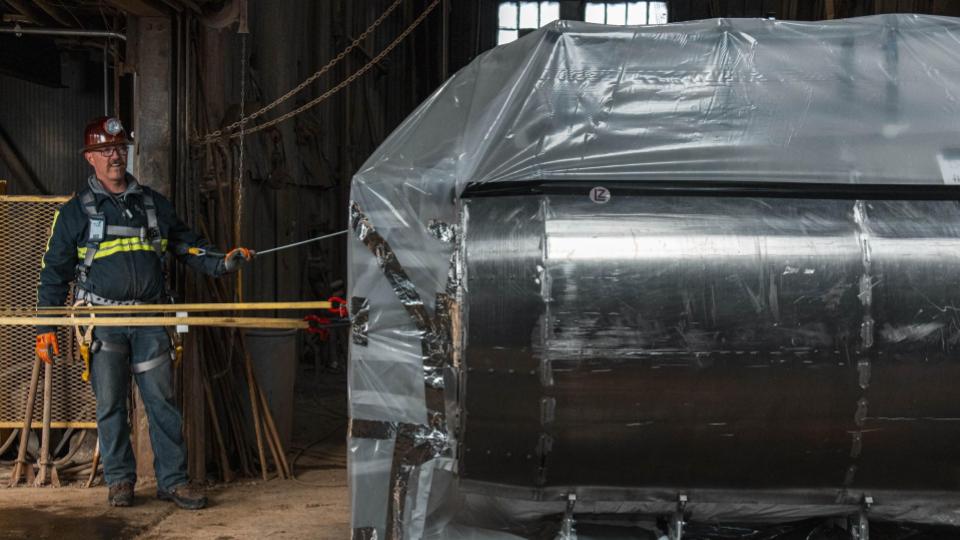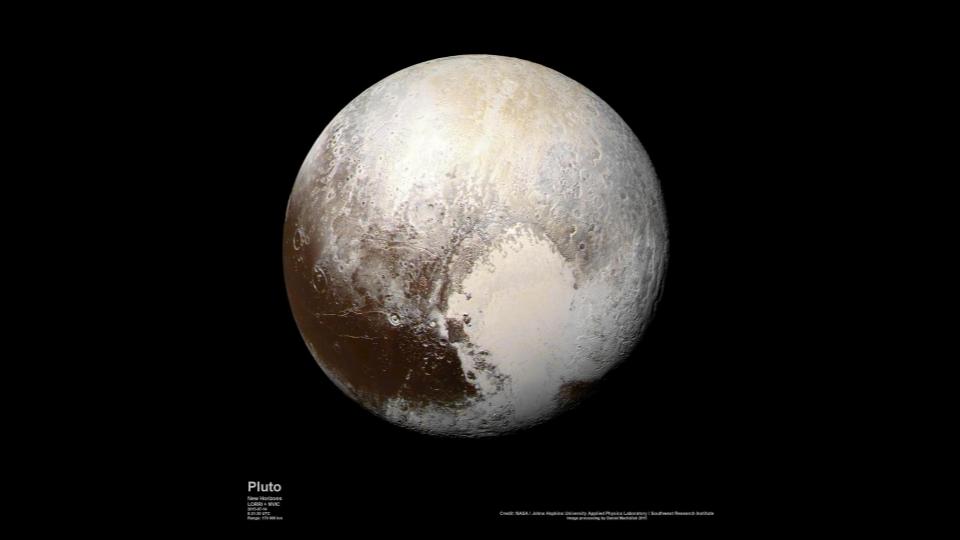Today is a day of instrument announcements and scrapping every last bit of science out of instruments. We go a mile underground to learn about the LUX-ZEPLIN detector and then climb to more than a mile-up to learn about the Dark Energy Spectroscopic Instrument at Kitt Peak. From there we dash out to Pluto and learn about its poorly understood, heartless side.
———————

- Particle detector for hunting dark matter installed a mile underground (Press Release)
- The LZ Dark Matter Experiment (Sanfordlab.org)
- LUX-ZEPLIN (Stanford National Accelerator Laboratory)
Today’s first astronomy story takes us nearly 1-mile underground. Deep beneath the hills of South Dakota, in a no-longer-active mine, researchers plan to hunt for something even more elusive than gold – they will be searching for Dark Matter. In a news release from University College London, we learn that the LUX-ZEPLIN experiment has been lowered 4,850 down a mining shaft. From its new resting spot, it will search for the particle signature of weakly interacting massive particles. These particles are theorized to be one of the possible components of Dark Matter.
Our universe is made, more or less, of three different kinds of stuff: There is the normal material – baryonic material – that we are made of. This is less than 5% of the universe. There is also Dark Energy, which no one knows what is, and it makes up 68% of the universe. Finally, we have Dark Matter, which makes up 27% of the universe and is some kind of a non-interacting particle. While we can readily map dark matter through its gravitational interactions with light and matter, scientists have so far been unable to study the individual particles that dark matter is composed of. The LUX-ZEPLIN project hopes to change that. This detector consists of a central detector embedded in a tank of scintillator liquid that is in turn surrounded by a layer of water – all buried under ground. It is hoped that the nearly mile of dirt and the buffer of water will absorb or deter all regular particles of reaching the scintillator liquid, while allowing dark matter particles to readily penetrate the system. Scintillator fluid, in this case liquid xenon chilled to -148F or -100C, should give off light when it interacts with dark matter particles – which should be among the only particles to reach this fluid! While dark matter is thought to mostly not interact with regular matter, it should sometimes interact, and sometimes is enough if you have a sensitive enough detector.
At this point, the LUX-ZEPLIN experiment is still under construction, and we are bringing you this story because sometimes the construction that goes into making these experiments is worth talking about. In this case, a global science team constructed a 2000kg instrument out of ultra-radio-pure titanium in a clean room, wrapped it in plastic, then added a transport structure, and more plastic, and lowered it into a mine where a new clean room was waiting to take delivery. To make sure they could successfully move this instrument they also constructed two dummy instruments and practiced moving those.
Now that the instrument has successfully made its way into the mine, the next several months will be spent wiring and cabling everything, making sure all vacuum seals work well, and then testing the generation of liquid Xenon. Project completion is planned for summer 2020. Here is to hoping they find dark matter particles shortly there after!
——————–

- DESI Opens Its 5,000 Eyes to Capture the Colors of the Cosmos (Press Release)
- Cosmic 3D Mapping Machine Opens 5,000 Robotic Eyes (Press Release)
- The Dark Energy Spectroscopic Instrument (DESI)
From nearly a mile underground, we now travel to a mountain more than a mile up, and a new detector designed to advance our understanding of Dark Energy. This is DESI, the Dark Energy Spectroscopic Instrument mounted on the 4-meter Mayall Telescope at Kitt Peak National Observatory in Arizona. This instrument is designed to measure the distances millions of galaxies across ⅓ of the sky, and use this map to steady how the universe has expanded as a function of time. To accomplish this task, the system will use 5000 robotically positioned fiber optics to take spectra which record the recession speed of galaxies across a myriad of distances. Constructed from components designed and manufactured by a collaboration spanning 75 institutions and 13 countries, DESI has been several years in the making, requiring 18 months just to be installed on the telescope. Now – it has had first light, and it is ready to start taking on one of the universe’s greatest mysteries. While DESI won’t directly detect whatever the heck Dark Energy is, the measurements it makes will document the effects of dark energy in unprecedented detail, and like surveys that have come before it, DESI will also allow us to do ancillary science to study galaxies in all their kinds across time.

DESI is expected to enter full science observations in early 2020, and it will take 5 years to complete its survey of more than 37 million objects. This is your reminder that Astronomy is a field for those capable of handling very-delayed gratification.
——————–

- Fresh Look at New Horizons Data Shows Pluto’s ‘Far Side’ in Unprecedented Detail (Gizmodo)
- New Horizons team pieces together the best images they have of Pluto’s far side (Phys.org)
- New Horizons Team Pieces Together the Best Images They Have of Pluto’s Far Side (Universe Today)
Actually, it’s not just Astronomy that makes researchers wait. Planetary Science is also filled with long months and years of waiting, and sometimes the results of that waiting aren’t fully satisfying. Pluto is a case in point. When New Horizons arrived at Pluto nine and a half years after its launch, it captured amazing images of the heart of Pluto. While this feature, and the surrounding features on that one face of Pluto have lead to numerous insights and research papers, this is only one half of this dwarf planet, and half a planet isn’t as satisfying as a whole planet.
New Horizons was able to image Pluto in the lead up to its July 4 flyby, and as this distant world rotated, the spacecraft obtained images of Pluto’s other side side at greater distances and thus at lower resolutions. In the 4 years since the flyby, New Horizon’s team scientists have been pouring through this lower resolution data, and working to find ways to combine it to get out every possible detail and every ounce of science.

In a new paper posted on ArXiv, Alan Stern and company post this new imagery and proposed names for the features they see in their maps. These features include a bulls-eye of a crater named Simonelli as well as a variety of linear features that are directly opposite from the heart shaped Sputnik Planitia. This new paper goes into potential geological causes for the different features, and we will do a deep dive into these results next Monday, so stay tuned!
———————
That rounds out our show for today.
Thank you all for listening. The Daily Space is produced by Susie Murph, and is a product of the Planetary Science Institute, a 501(c)3 non profit dedicated to exploring our Solar System and beyond. We are made possible through the generous contributions of people like you. If you would like to learn more, please check us out on patreon.com/cosmoquestx
Each live episode of the Daily Space is archived on YouTube. If you miss an episode here on Twitch.tv, you can find it later on youtube.com/c/cosmoquest. These episodes are edited and produced by Susie Murph.
We are here thanks to the generous contributions of people like you who allow us to pay our staff a living wage. Every bit, every sub, and every dollar committed on Patreon.com/cosmoquestx really helps. If you can’t give financially, we really do understand, and there are other ways you can help our programs. Right now, the best way you can help is to get the word out. Let you friends know, share our channel to your social media, or leave a recommendation. You never know what doors you are opening.
We really wouldn’t be here without you – thank you for all that you do.


 We record most shows live, on Twitch. Follow us today to get alerts when we go live.
We record most shows live, on Twitch. Follow us today to get alerts when we go live.